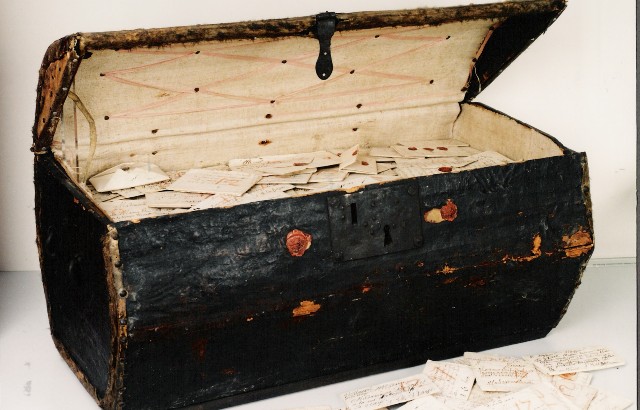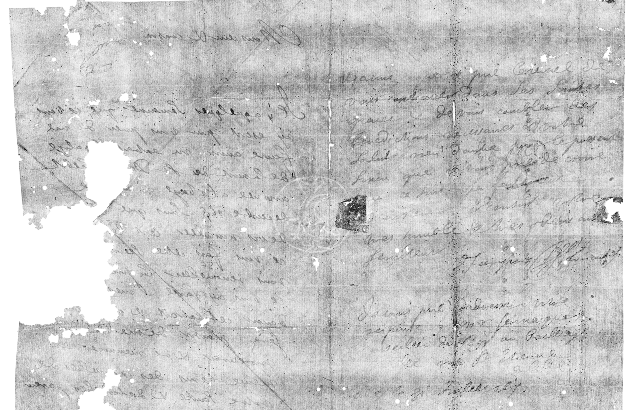In other news...
Institute of Dentistry staff and students have collaborated with colleagues on two exciting initiatives that apply modern techniques to projects with a historic twist.
Secrets of sealed 17th century letters revealed by dental X-ray scanners
In a world first, an international team of researchers has read an unopened letter from Renaissance Europe – without breaking its seal or damaging it in any way.
The research, published in Nature Communications, describes how an X-ray scanner used in dental research and ‘virtual unfolding’ allowed the interdisciplinary team to read the contents of a securely and intricately folded letter which has remained unopened for 300 years, while preserving its valuable physical evidence.
A highly sensitive X-ray microtomography scanner, developed at Queen Mary’s dental research labs, was used to scan a batch of unopened letters from a 17th century postal trunk full of undelivered mail.

The senders of these letters had closed them using ‘letterlocking’ - the historical process of intricately folding and securing a flat sheet of paper to become its own envelope. Letterlocking was common practice for secure communication before modern envelopes came into use, and is considered to be the missing link between ancient physical communications security techniques and modern digital cryptography.
Until now these letterpackets could only be studied and read by cutting them open, often damaging the historical documents. Now the team have been able to examine the letters’ contents without irrevocably damaging the systems that secured them.
Professor Graham Davis said: “We designed our X-ray scanner to have unprecedented sensitivity for mapping the mineral content of teeth, which is invaluable in dental research. But this high sensitivity has also made it possible to resolve certain types of ink in paper and parchment. It’s incredible to think that a scanner designed to look at teeth has taken us this far.”
Dr David Mills said: “We’ve been able to use our scanners to X-ray history. The scanning technology is similar to medical CT scanners, but using much more intense X-rays which allow us to see the minute traces of metal in the ink used to write these letters. The rest of the team were then able to take our scan images and turn them into letters they could open virtually and read for the first time in over 300 years.”
This process revealed the contents of a letter dated July 31, 1697. It contains a request from Jacques Sennacques to his cousin Pierre Le Pers, a French merchant in The Hague, for a certified copy of a death notice of one Daniel Le Pers. The letter gives a fascinating insight into the lives and concerns of ordinary people in a tumultuous period of European history, when correspondence networks held families, communities, and commerce together over vast distances.

Following the X-ray microtomography scanning of the letter packets, the international team then applied computational algorithms to the scan images to identify and separate the different layers of the folded letter and ‘virtually unfold’ it.
The authors suggest that the virtual unfolding method, and categorisation of folding techniques, could help researchers to understand this historical version of physical cryptography, while at the same time conserving their cultural heritage.
Collaborating on a new take on an ancient recycling idea
A team from Queen Mary's Institute of Dentistry collaborated with Jade Echard, an Industrial Design Masters student at Central Saint Martins, London, to help with synthesis of her recyclable ceramic products produced from oyster shell waste. Jade’s work recently won the ‘Sustainable Solution’ category in the WantedDesign Conscious Design Awards. The Awards for Best Student Projects are presented with Metropolis magazine and the support of the International Interior Design Association (IIDA).
-and-OSTRA-range.png)
Jade has been exploring the potential for transformation of organic waste, thanks to an ancient Roman recipe for concrete – OSTRA. Her project aimed to rethink oyster shells as a valuable, sustainable and local resource by developing a range of products in the context of a circular economy.
The Queen Mary team included staff and a PhD student from the Centre of Oral Bioengineering and the Centre for Teaching and Innovation at the Institute of Dentistry.